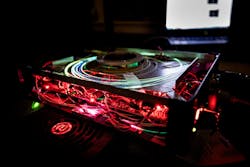Infrared laser method could diagnose brain concussions
With no way to reliably tell whether an athlete has a concussion, many may be playing with an undiagnosed injury. Likewise, two million people die every year because we don’t have an early warning when brain cells are dying--and another four million experience cognitive disabilities.
Now, a team of doctors and engineers from the University of Michigan (U-M; Ann Arbor, MI) has developed a noninvasive way to measure whether brain cells are in distress using an infrared laser. Their device uses optical fibers to deliver pulses of infrared light to a person’s forehead. This light can penetrate through the skin and skull to the brain without doing harm. It interacts with an important molecule for metabolism called cytochrome C oxidase, or CCO.
While existing technology can give real-time information on whether the brain is getting oxygen, this new device gives information about whether the brain cells are able to use that oxygen. This information could enable concussions to be diagnosed on the sidelines of an athletic event. Alternatively, it could provide rapid feedback as doctors adjust treatment in the ER, operating room or the intensive care unit.
Mohammed Islam, professor of electrical engineering and computer science, will present the study on Super Bowl Sunday at the Photonics West conference in San Francisco. He and his collaborators at Michigan Medicine, the School of Kinesiology and the College of Literature, Science, and the Arts describe how the new technique works:
There is a part of CCO that is excited by light with wavelengths between 750 nm and 900 nm. If you pluck a string on a violin, you hear its resonant frequency. CCO has, if you like, a string that we pluck with the laser, one can see the resonant frequency in the light recorded.
Previous experiments used infrared lamps, but the signal from the CCO is not very distinct. Hemoglobin, which tells us about blood oxygen levels, also responds to the range of wavelengths used to probe CCO, and it is 10 to 20 times more plentiful in human tissue. A stronger signal from the CCO was needed to distinguish it from the hemoglobin and other molecules in the body, and the result was a stronger response by using a laser that is nearly 10 times brighter than the lamps.
That increased brightness, along with measurement techniques to suppress noise during the measurements, was critical to enabling the conclusive measurements of CCO during cognitive attention tests with a portable, noninvasive device. Such attention tests are often used with concussion patients.
The paper on this work is titled, “Brain metabolism monitoring through CCO measurements using all-fiber-integrated super-continuum source.” U-M is pursuing patent protection and seeking partners to bring the technology to market.
SOURCE: University of Michigan; https://news.umich.edu/toward-a-portable-concussion-detector-that-relies-on-an-infrared-laser/
About the Author

Gail Overton
Senior Editor (2004-2020)
Gail has more than 30 years of engineering, marketing, product management, and editorial experience in the photonics and optical communications industry. Before joining the staff at Laser Focus World in 2004, she held many product management and product marketing roles in the fiber-optics industry, most notably at Hughes (El Segundo, CA), GTE Labs (Waltham, MA), Corning (Corning, NY), Photon Kinetics (Beaverton, OR), and Newport Corporation (Irvine, CA). During her marketing career, Gail published articles in WDM Solutions and Sensors magazine and traveled internationally to conduct product and sales training. Gail received her BS degree in physics, with an emphasis in optics, from San Diego State University in San Diego, CA in May 1986.
